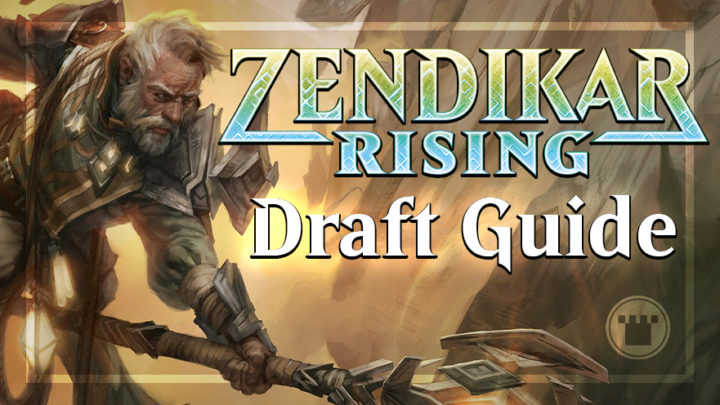This past week has seen drafters on MTG Arena and MTGO make their long-awaited return to Zendikar — and the plane of hedrons is NOT as we left it! Not only are we free to explore the wilds without Eldrazi interference for the first time since original Zendikar, but there are these new double-faced “spell lands” running around everywhere, challenging our fundamental assumptions about Limited.
If you’re looking to launch into Zendikar Rising draft, welcome to the official Card Kingdom guide for the set. The early consensus among famous drafters is that this is another great format in WotC’s recent hot streak — but it is not an easy or familiar one. Still, with the right changes to the typical drafting mindset, you’ll be caught up on the early grinders in no time!
SET MECHANICS
“SPELL LANDS”/MODAL DOUBLE-FACED CARDS
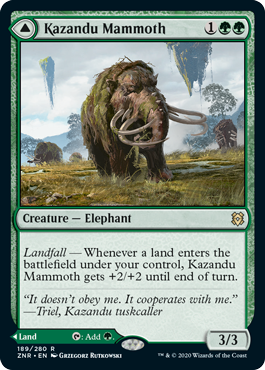
Let’s address the elephant in the room right away.
All colors in Zendikar Rising include double-faced cards at uncommon, rare and mythic rare; the front side of these cards offers a typical spell, and the back side is always a land. Unlike previous double-faced cards that required a trigger to “transform” into their back side while in play, the ZNR versions simply allow players to choose which side of the card to play at the time they play it — closer to how split cards functioned in Guilds of Ravnica.
While the actual spells and lands printed on these modal double-faced cards (which I’ll hereafter call “spell-lands”) seem mediocre, the flexibility is an incredibly powerful guard against mana screw/flood and a way to add “free value” to your decks. There are also six more rare modal double-faced cards with two land sides, each providing an untapped source for a different color — with the caveat that, like the spell-lands, the chosen side cannot be changed once played.
As with all double-faced cards, these cards “count as” the side you played them on while on the stack or the battlefield, and as their front side everywhere else. So the spell-land creatures can be picked up from the graveyard by your Gravedigger, but not put into play as a land from an Uro trigger.
For more info on modal DFC’s, check out our article here.
PARTY
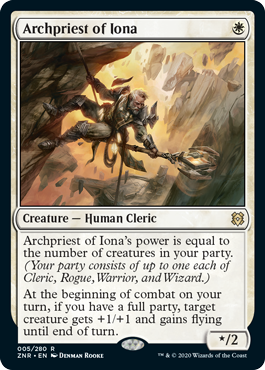
Introducing spell-lands instantly adds a huge new layer of decision-making to Zendikar Rising, so the other set mechanics are more straightforward to compensate. The only other brand-new mechanic is Party, which represents the D&D-style adventuring groups that roam the plane. Party appears in all five colors and at every rarity level — you can’t play ZNR without it!
Party works like devotion: a score that’s constantly updated based on the permanents you have in play. Any time an effect asks for “the number of creatures in your party,” look to see if you control at least one warrior among your creatures. Then check for at least one rogue, cleric, and wizard as well. Even if the same creature has more than one of those types, you can only count it once. “The number of creatures in your party” is however many of those types you can currently represent — a number between zero and four. A handful of rares ask whether you control “a full party,” which means a party of exactly four — at least one representative of each type.
It never matters which creatures specifically make up your party; so long as you control at least one warrior, your warrior slot is full. Many creatures with party-dependent abilities also belong to an eligible type; they count themselves for their effects, so Malakir Blood-Priest will always drain for at least one.
KICKER
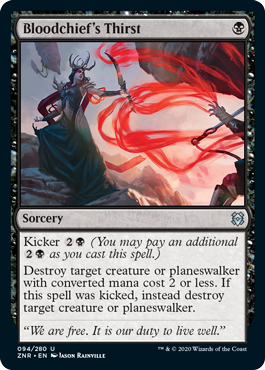
One way to keep the crowd happy and the set simple is to bring back one of Magic’s most familiar, intuitive and beloved mechanics: kicker. Many spells in Zendikar Rising have kicker costs — a fixed premium you can pay on top of the normal cost as you cast it to get a bigger effect than usual. In Zendikar Rising, cards with kicker appear across all colors, but as a mechanic, its direct support is in UG.
LANDFALL
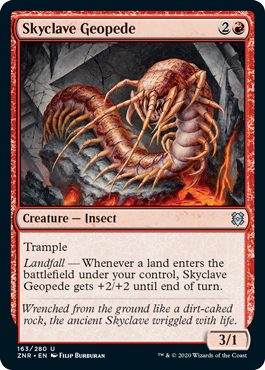
Would we really be on Zendikar without this one? Permanents with landfall each have some sort of triggered ability that goes on the stack whenever a land enters the battlefield under your control. This counts whether the land was a spell-land or ordinary basic, whether it was your natural land drop or one you searched into play with a Cultivate in Constructed.
Landfall is yet another way to smooth out the variance of the draw step, giving even your top-decked lands a valuable effect. As with ZNR’s other mechanics, landfall is featured in all colors, but it does have a bias toward red, white, and green.
ARCHETYPES
Astute readers may have noticed in the last section that Zendikar Rising has no clear color boundaries between its featured mechanics; every synergy is represented across every color to some degree. This also impacts our typical understanding of draft archetypes — rather than UW being “the party deck,” RG being “the landfall deck” and so on, the average draft deck ends up with its own unique mix of mechanics and payoffs to juggle.
But the true cleverness of Zendikar Rising’s design becomes clear when you look more closely at the cards in each theme and notice the density with which they overlap; almost every card supports multiple major themes. Many landfall or party payoffs take the form of lifegain; the best lifegain payoffs gain +1/+1 counters whenever you gain life, and those payoff creatures are themselves clerics, eligible to join your party!
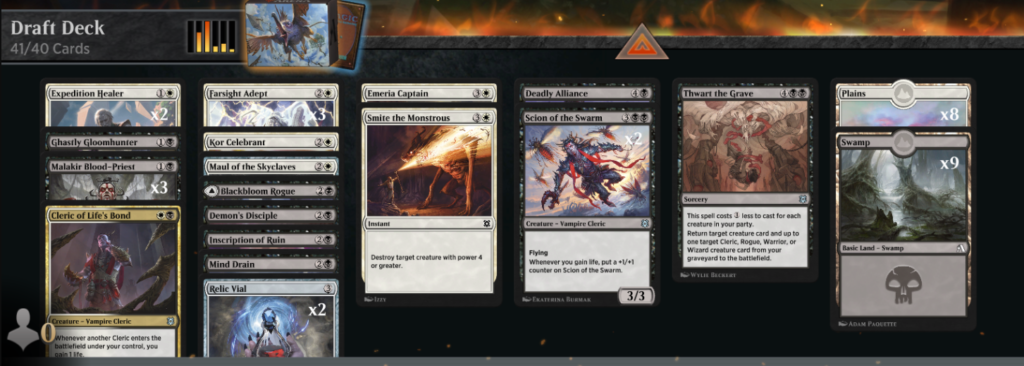
It’s important to make clear that there is no dedicated “party deck” in specific colors here. Rather, your balance of creature types becomes an additional, ever-present scale of card evaluation, where you will eventually prioritize supporting one specific type, an even mix of types, or perhaps none if you’re going hard into landfall.
That’s not to say the colors and pairs are all the same, though. Each of the four party types has tribal support in a specific pair — warriors in RW, clerics in WB, wizards in UR, and rogues in UB. Green has solid examples of all four types, plus some unique placeholders who count as whichever party slot you’re missing, but its party payoffs are the weakest. Instead, green gets the best coverage in ZNR’s remaining mechanics; there’s a strong kicker theme through Sultai and especially UG, a strong landfall theme through Naya, and a +1/+1 counters theme through Abzan.
As you begin to spot more of these potential synergies, the temptation rises to try and support every possible theme at once. It gets risky to try and juggle too many things like this — but if you can keep your mind and your draft open to the more unconventional card combinations, you will find many rewarding moments in Zendikar Rising Limited. Here are the elements I’m prioritizing in different color pairs after a few days immersed in the format:
GW
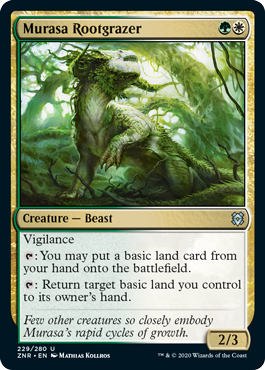
Many other Limited set reviewers have pegged blue as the most powerful color in ZNR, but I personally think green has some strong edges. It has the best non-rare creatures, about the only fixing, and strong game plans with nearly every partner color. In GW, the shared emphasis is on landfall, and particularly a slower style that builds +1/+1 counters on creatures until your size advantage is unbeatable. In a set with such a small average creature size, a traditional go-wide-and-pump strategy around Canyon Jerboa, Sea Gate Banneret and Vastwood Surge can also have a huge impact.
RW
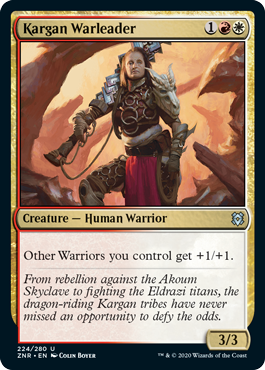
Nothing new or fancy here; RW is the format’s best aggro deck, low-slung and straightforward. (I guess somebody has to be?) The tribal support for warriors is quite good, and can be mixed fairly well with a smattering of wizards, clerics and rogues to enable some of the party support in these colors — particularly removal like Journey to Oblivion or Practiced Tactics. It’s quite hard to push damage without losing lots of creatures, so you need cheap removal like Tactics or Sizzling Barrage to clear a path and deal 20. There is also an equipment subtheme here; unfortunately, the non-rares aren’t worth lowering your creature count for.
UG
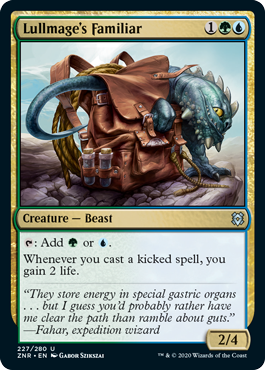
These colors have the strongest identity out of any pair, being clearly saddled with “the kicker deck” from day one. But many drafters — myself included — assessed the kicker game plan incorrectly at first glance. Instead of long-term value, a heavy kicker deck wants to play tempo, depending on bounce from Into the Roil and Cunning Geysermage, efficient beef from Vine Gecko and Gnarlid Colony, and preferably, several copies of the terrifying Risen Riptide. A 0/5 wall is already way better than you’d expect in this context, blocking almost any non-rare creature, but when it can attack freely and threaten to become a 10/10 with one Might of Murasa, it becomes impossible to deal with in multiples.
BG
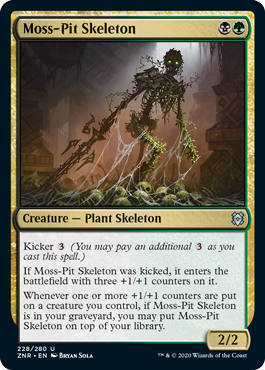
My favorite color pair in Zendikar Rising so far is green-black, and it’s not close. Golgari combines the most solid common creatures with the most powerful common removal, slathers it in an overlapping mix of the set’s mechanical themes, and sprinkles in some powerful graveyard elements for good measure. The set’s consistency means most decks can do something most turns, so having the bigger cards to trade with and the best suite of recursion is one of the surest paths to victory.
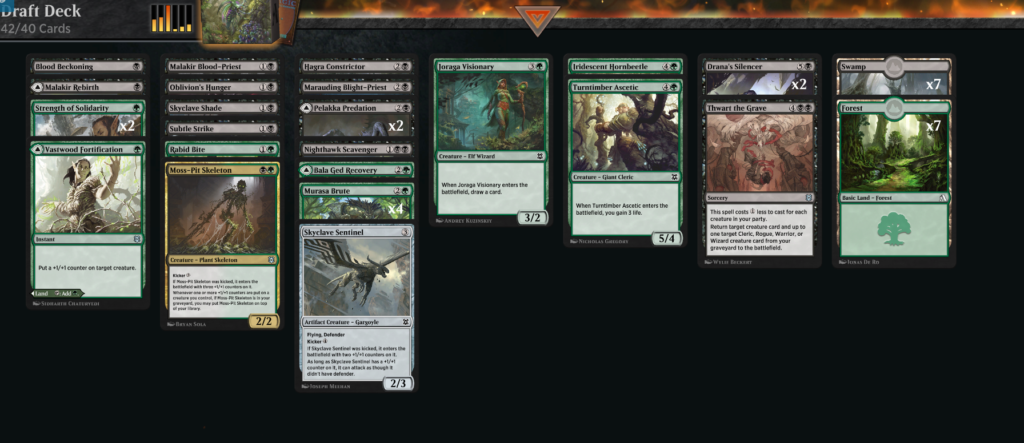
BR
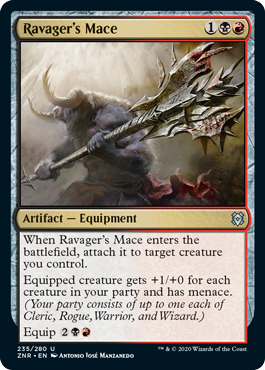
One of the most cryptic combinations to try and assess from the card spoilers alone, RB admittedly has even less of a cohesive game plan than the other color pairs. Most of its options are aggressive, trending back toward midrange. On the cheaper end of the curve, this color pair has the best common party effects — Malakir Blood-Priest, Grotag Bug-Catcher, Thundering Sparkmage, Shatterskull Minotaur, Deadly Alliance, and Ravager’s Mace among them. But you can also use the stellar removal suite to back up a surprising landfall midrange plan — cards like Cleansing Wildfire and Pyroclastic Hellion trigger Akoum Hellhound, Skyclave Geopede, and Dreadwurm. Remember that Blood Beckoning — already among the most exciting black cards — can be used to recover Akoum Warrior and Blackbloom Rogue if you need emergency land drops!
WB
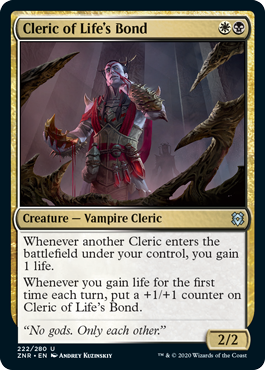
Cleric colors. Probably the most powerful of the party tribes to commit to heavily in draft, the cleric deck needs to see a critical mass of its more powerful cards; just grabbing every Malakir Blood-Priest you see won’t cut it when your average party size is 1. Regardless of whether you’re building around Orah, Skyclave Hierophant, Relic Vial, or just whatever copies of Thwart the Grave you could lay hands on, this deck is built for attrition and incidental value. Cleric of Life’s Bond and Scion of the Swarm are big pay-offs, but Marauding Blight-Priest can be just as good and sits in a decent spot for stats. Best of all is white’s unexpected best common, Kor Celebrant! It might not look like much, but a 1/4 blocks almost everything outside of green and the trigger is the easiest way to get your payoff cards rolling.
UB

Rogue colors. While I love the feel of rogues for Constructed, I’m not quite sold on them as an all-in Limited strategy the way I am with clerics or even wizards and warriors. Instead, these colors end up aspiring to be UB mill, and not usually working out unless you can pick up a Maddening Cacophony or two. That being said, I have yet to even see someone put Relic Golem on the stack, and that card looks wicked good. Don’t write UB off, just focus on grabbing good cards over synergy.
UW
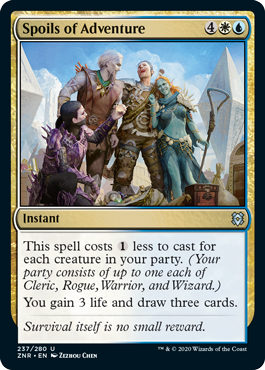
This was speculated to be the “party tempo” deck, and to be fair, that’s an option in Constructed. Unfortunately, all the good aggro creatures are at rare, so in reality, the best UW decks play a classic Skies strategy. Flyers of any kind are amazing in this trade-happy set, to the point that Cliffhaven Kitesail is one of the best pieces of equipment. UW has access to extremely powerful flyers from three mana upwards, and packs plenty of defensive cards to keep you in the game until your angels and wizards close things out. Even the angels have party types in this set, so you can still cap things off with the excellent Spoils of Adventure at a discount.
RG
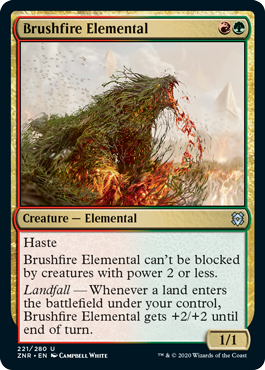
I’ll be honest, it took me until my tenth draft run to encounter somebody playing a RG deck, and it was only when I was in the middle of that match that I even realized it had been missing. For once, these two don’t pair well at all; green’s slow and value-driven game clashes with red’s necessary aggression. Red doesn’t have the best party payoffs to start, and green brings none to the table, just enablers. In theory, this should probably be a landfall deck, but I prefer the GW version of that plan just like I prefer RW for aggro. I don’t see this one being a late mover, either — just stay away.
UR

Wizard colors. Favored early by a lot of drafters, particularly those who like to maximize their odds of tempoing out fast wins. It’s already easy to steamroll games in the format — since both players are more consistently casting their spells, the first person to get a lead on board can often start chipping in turn after turn while relentlessly exchanging removal and creatures for opposing blockers. Also, since a lot of wizards have kicker and green adds several good wizards of its own, this deck can easily be Temur; I wouldn’t always recommend splashing in the format, but it’s worth it to play mono-wizards and have every spell in your deck triggering Umara Mystic!
TOP CARDS
While the matter of card evaluation for this set is very nuanced and situational, there’s a few commons and uncommons that have leapt out as big indicators of success. Here are your signs of where to go if you aren’t handed a big rare in pack 1:
WHITE
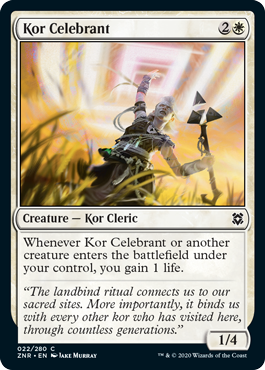
Kor Celebrant: See the WB section above. There’s a lot of value in a creature that never dies and contributes to your party size, and the fact this also generates life is gravy.
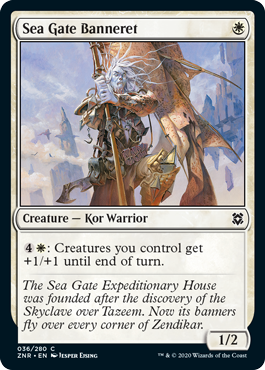
Sea Gate Banneret: I’m not normally wild about one-drops in draft, but as I hinted above, the +1/+1 activation goes very, very far in a set with playable 6-mana 3/2’s. A terrific bonus to any white deck, but especially GW and RW.
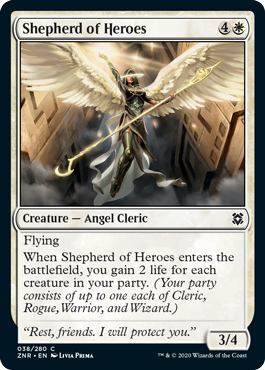
Shepherd of Heroes: This is a better version of the 4W common flyer that already gets top marks in other draft sets. Great when in front or behind.
GREEN
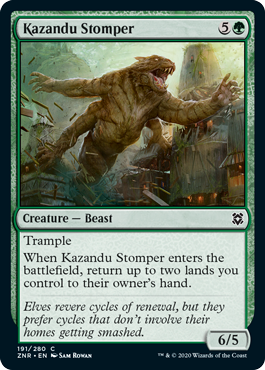
Kazandu Stomper: This and the other cards that pick up lands on ETB look a little funny at first — until you see them bounce a spell-land that got played as a land on turn two, and you suddenly die to Zof Consumption!
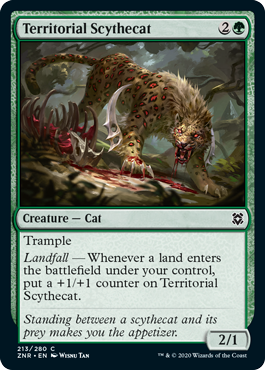
Territorial Scythecat: One of the best landfall cards in the set, and made better by being in a color which can trigger it at instant speed.

Skyclave Pick-Axe: I’ll add the caveat that I’ve not seen this one cast in a game yet, but I have a hunch that if the RG or Naya landfall deck is going to work out, it’ll be thanks to these equipped on something nasty.
BLUE
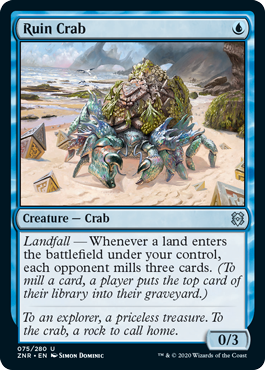
Ruin Crab: Everybody loves crabs in Magic — they make milling fun! Obviously, with a lower target number to shoot for in Draft and no pesky Uro to accidentally switch on, this strategy becomes pretty real, so if you get a couple, go for your life!
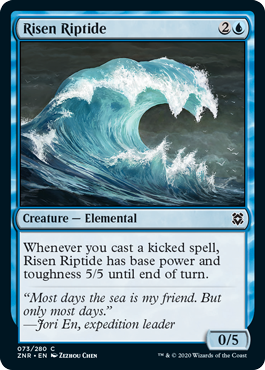
Risen Riptide: So many cards in this set coincidentally have kicker, and this card would be fringe playable as a blank 0/5. Draft it (and fellow payoff Roost of Drakes) wherever you can.

Expedition Diviner: This is somehow one of the better wizards and better flyers while being a four-mana common. I don’t need many other wizards to convince me to play this, but it is extremely easy to get them.
RED
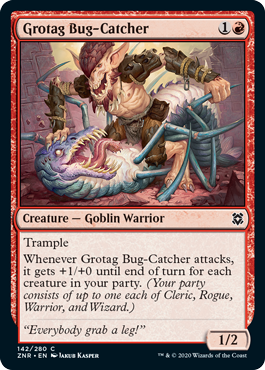
Grotag Bug-Catcher: I was only half-joking when I argued to a friend today that this was the best party payoff creature in the set. It’s not much on defense, but if you just jam multiples of these alongside some other cheap party members you will be doing rare damage numbers for ZNR. Combos with Sneaking Guide in a board stall.

Rockslide Sorcerer: DEFINITELY a card you need to see in action. This fella is the bane of the format’s many X/1’s and messer-up of combat math. But more than that, it feels like the red removal in the set was balanced around his damage-amplifying trigger; suddenly your Molten Blast and Spikefield Hazard can get value!
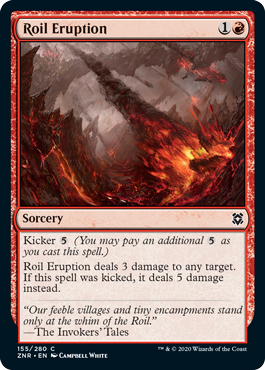
Roil Eruption: This is what burn spells have been reduced to: Volcanic Hammer with slight upside. Okay, more than slight upside. Definitely take this even if resentfully.
BLACK
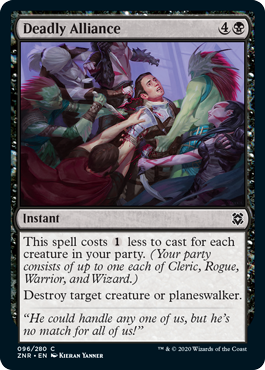
Deadly Alliance: It’s not very groundbreaking to say that the unconditional instant-speed removal spell is black’s best common, but that stays the case here — especially since you can end up casting it for one mana!
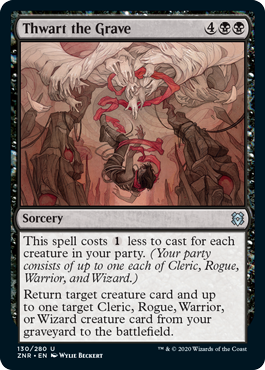
Thwart the Grave: Again, I feel like this card is very obviously near the top end of power in the set. I want to reinforce, though — this might be the best non-rare and certainly the best party payoff. It grabs your biggest creature whether it’s a party member or not!
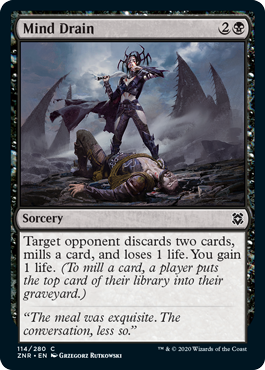
Mind Drain: I’m not usually the person advocating for Mind Rot in draft, but this generates a lifegain trigger, fills their yard for your rogues, and generally hits harder in a set where opponents often spend several turns setting up a big party or landfall payoff.
PARTING COMMANDMENTS
Hear ye these words, my students, and hold them dear above all:
- PIVOT INTO YOUR RARES
Rare creatures in this set are wildly powerful compared to the rest. You need the bombs. - DON’T PLAY MORE THAN TWO COLORS
If you’re brave you can splash a third to comply with commandment 1; remember that Cleansing Wildfire and Lithoform Blight are sneaky self-replacing mana-fixers. - HOLD THE CREATURE (AND REMOVAL) COUNT SACRED
As mentioned, you can lose a ton of games by getting kept off the board after a slow start. It’s harder to keep your creatures alive than to just play 17+ of them. - VISUALIZE YOUR SPELL-LANDS IN ACTION
Spell-lands should be exchanged for basics at something less than 1:1 ratio. Imagine each spell side and consider how likely you are to want that side in a match; if it’s a great bit of removal you’ll always want to hold and cast, that’s not a card you can play in a land slot. - YOUR VICTORY IS IN THE SKIES, NOT THE NEXT CARD DOWN
This set improves the quality of the average draw, making it harder to overwhelm people with grindy value based decks or to push lethal damage through a board stall. Only a few colors even have large flyers so if you can stick one to the board, it will always become a must-remove threat.
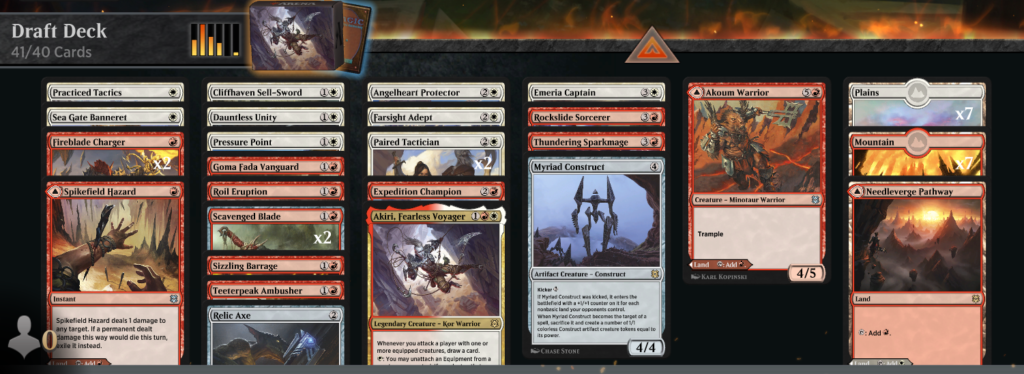
And that’s the best advice I can give you on how to handle yourselves in these early weeks of Zendikar Rising Limited. The format is a really unique and interesting kind of draft that promises to reward those who sink the time to really get a feel for balancing their party and sequencing spell-lands. If you don’t mind having to invent your own draft archetypes on the fly, then I heartily recommend making Zendikar your next party to crash!

Tom’s fate was sealed in 7th grade when his friend lent him a pile of commons to play Magic. He quickly picked up Boros and Orzhov decks in Ravnica block and has remained a staunch white magician ever since. A fan of all Constructed formats, he enjoys studying the history of the tournament meta. He specializes in midrange decks, especially Death & Taxes and Martyr Proc. One day, he swears he will win an MCQ with Evershrike. Ask him how at @AWanderingBard, or watch him stream Magic at twitch.tv/TheWanderingBard.

